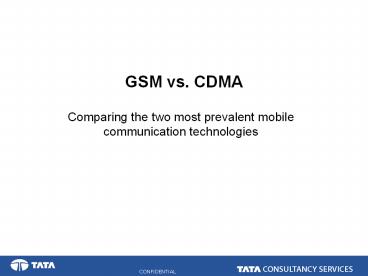GSM vs. CDMA - PowerPoint PPT Presentation
1 / 16
Title:
GSM vs. CDMA
Description:
GSM vs. CDMA Comparing the two most prevalent mobile communication technologies What is ? GSM (Global System for Mobile Communication) Based on TDMA technology ... – PowerPoint PPT presentation
Number of Views:552
Avg rating:3.0/5.0
Title: GSM vs. CDMA
1
GSM vs. CDMA
Comparing the two most prevalent mobile
communication technologies
2
What is ?
- GSM (Global System for Mobile Communication)
- Based on TDMA technology
- Mainly used in Europe, Middle-east and Africa
- CDMA (Code Division Multiple Access)
- Based on a spread-spectrum technology
- Mainly used in North America
3
Technology FDMA
- Transmission over Radio Frequency (800MHz
1900MHz) - Frequency Division Multiple Access
- An analog system. Each user is given one channel
(i.e., one frequency). Bad utilisation.
CH 2
CH 1
4
Technology TDMA
- GSM uses TDMA (Time Division Multiple Access)
- CDMA is a "spread spectrum" technology, allowing
many users to occupy the same time and frequency
allocations in a given band/space. - Each mobile station has a unique digital code.
The signals are spread over the entire spectrum
of 1.25MHz unlike FDMA/TDMA.
Power
Time
Frequency
Channel 3
Channel 4
Channel 1
Channel 2
5
Spectrum
- Mobile communication uses Radio Frequency (RF)
- GSM uses frequencies 824 849 MHz (25 MHz band)
and 869 895 MHz (25 MHz band)
6
Cellular Architecture
HLR
A
BSC
Abis
VLR
Um
PSTN
MSC
BSC
EIR
AuC
BTS
Mobile Station
Base Station Subsystem
Network Subsystem
7
Cells
- The coverage area is divided into hexagonal cells
- A BTS is situated at three of the vertices of
each cell - In USA, the spectrum in each cell is divided into
two bands A-band and B-band, each 25 MHz - Each 25 MHz band is divided into 832 30 kHz
channels - Two channels separated by 45 MHz
- forms a full-duplex channel
- The number of channels used in a cell
- varies from as low as 4 to as many as 80
8
GSM Frames and Burst periods
BP Burst Period
TCH Traffic Channel
SACCH Assoc. Control Channel
9
Handover/Handoff
- Internal Handovers (only one BSC involved)
- Channels in the same cell
- Cells under the same BSC
- External Handovers (involved the MSC)
- Cells under different BSCs under the same MSC
- Cells under different MSCs (anchor MSC and relay
MSC) - Techniques used
- Minimum acceptable performance increase power
i.s.o. handover - Power budget handover i.s.o. increasing power
10
Services
- SMS (Short Message Service) http//www.gsmworld.co
m/technology/sms/intro.shtml - Facsimile (for receiving fax on a mobile station)
- WAP (Wireless Application Protocol) a standard
to let wireless equipment access the Internet. A
Wireless Markup Language (WML) is used to encode
the pages instead of HTML. - MMS (Multimedia Message Service)
- EDGE (Enhanced Data rates for GSM evolution)
- The ever elusive Killer app
11
History and proponents
- Group Spéciale Mobile
- Cellular services started in Europe in 1982
- 13 operators in Europe sign a MoU in 1987
- Radiolinja Oy became the first GSM network
operator in 1992
- cdmaOne (2G)
- IS-95A (First CDMA cellular standard)
- First deployed in Sep 1996 by Hutchison
- IS-95B (2.5G)
- First deployed in Sep 1999 in Korea
- CDMA2000 (3G)
- CDMA2000 1X (Phase 1)
- Deployed in Korea in 2000
- CDMA2000 1x EV-DO
- CDMA2000 1x EV-DV
12
Standards and standardization
- GSM coordinated by 3GPP
- Release 99
- Release 4 (was Release 2000)
- W-CDMA (Widebad CDMA) coordinated by 3GPP2
- B-CDMA (Broadband CDMA)
- cdmaOne (2G)
- IS-95A
- 1.25MHz CDMA channels
- circuit switched data connections at 14.4kbps
- IS-95B (2.5G)
- CDMA2000 (3G)
- CDMA2000 1X (Phase 1)
13
Statistics (Geography-wise)
- Over 1 billion GSM subscribers
- Over 170 million CDMA subscribers
14
Statistics (Subscriber growth)
15
Glossary
- GPRS General Packet Radio Service GPRS
represents first implementation of packet
switching within GSM, precursor to 3G - GGSN Gateway GPRS Support Node the gateway
between the cellular network and the IP network
16
References
- GSM Association website, at http//www.gsmworld.co
m - CDMA Development group, at http//www.cdg.com
- UMTS World, at http//www.umtsworld.com
- How Stuff Works Cell Phones, at
http//electronics.howstuffworks.com/cell-phone.ht
m - Cellular Telephone Basics, at http//www.privatel
ine.com/Cellbasics/Cellbasics.html - GSM overview, at http//ccnga.uwaterloo.ca/jscour
ia/GSM/gsmreport.html































